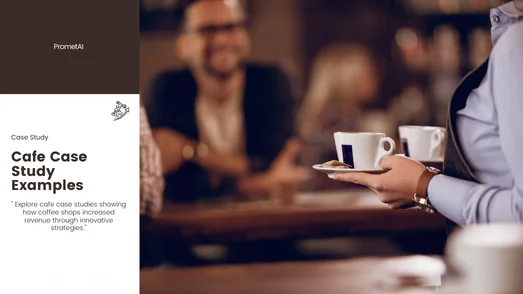Explore cafe case studies showing how coffee shops increased revenue through innovative strategies - hybrid models, sustainability, and community engagement.
Case Study 1: How NightOwl Café Reinvented Itself as a 24/7 Co-Living Hub and Increased Revenue 63%
Seoul is a city that never sleeps, and neither do its cafés. In a landscape where students, freelancers, and night-shift workers fuel themselves on lattes at all hours, NightOwl Café launched in 2016 as one of the city’s few 24/7 coffee shops. At first, it offered little more than what every other café did: a place to sip coffee and linger. But what began as a straightforward business soon transformed into one of the boldest café innovations Seoul had ever seen.
By 2019, NightOwl was no longer just a coffee shop. It had evolved into a hybrid co-living café model with 100 seats and 12 rentable pods, offering a mix of study, rest, and community-driven experiences that redefined what a café could be.
About the Business
Name: NightOwl Café
Location: Seoul, South Korea
Type: 24/7 coffee shop with hybrid co-living model
Founded: 2016
Capacity: 100 seats + 12 sleep/work pods
Running a coffee shop in Seoul is not for the faint of heart. The city is a global capital of café culture, with thousands of options on every corner. For independents like NightOwl, survival meant playing in a brutally competitive field.
Margins under siege. Standard coffee sales barely covered operating costs. Even with constant traffic, profits remained razor thin.
Price wars everywhere. Chains undercut independents with discounts, while boutique cafés fought to differentiate with elaborate menus. The result? A race to the bottom.
Identity without profitability. NightOwl’s 24/7 positioning attracted plenty of students, but most spent the night nursing a single Americano. High traffic didn’t translate into sustainable revenue.
Fixed costs crushing the bottom line. Seoul’s premium rents and rising staffing expenses meant the business was trapped in an unsustainable cycle: more hours open, but no growth in profitability.
By 2018, NightOwl was at a breaking point. Without a radical shift, it would either become another casualty of Seoul’s café price wars or quietly fade into irrelevance.
NightOwl’s leadership realized that competing on coffee alone was a losing game. Instead of trying to win on taste or price, they asked a radical question: what if the café became more than a café?
Space Innovation Through Pod Installation
The answer started with space. Unused corners and underperforming seating areas were converted into sleep/work pods. Outfitted with charging ports, Wi-Fi, and soundproofing, they gave customers the option to rent rest or work time by the hour.
This move turned every square foot into a revenue generator. Where a single latte once yielded $4, the same floor space now earns multiple times that through pod rentals. The café effectively invented its own co-living café concept, a hybrid between a study lounge, capsule hotel, and coffee shop.
Strategic Customer Segment Expansion
Instead of chasing the same customers as every other café, NightOwl expanded its scope. It actively targeted freelancers who needed an affordable workspace, gamers looking for a social-yet-private environment, and international travelers searching for short-term rest.
NightOwl introduced membership packages with unlimited coffee and discounted pod hours, turning casual customers into loyal, recurring members.
Community-Centric Programming
NightOwl didn’t just rent pods; it built culture. Weekly events included:
All-night coding marathons for developers.
Gaming tournaments that drew e-sports fans.
Language exchanges that brought together Seoul’s international community.
These programs positioned the café as more than a transaction - it became a safe and social alternative to Seoul’s late-night bars or karaoke rooms.
Digital-First Marketing Approach
Rather than traditional ads, NightOwl mastered the TikTok café marketing wave. Videos of futuristic pods and vibrant overnight events went viral, while Instagram-worthy interiors kept the brand circulating online. Partnerships with universities and co-working hubs further expanded visibility.
What emerged was not a coffee shop with side offerings, but a hybrid lifestyle hub where caffeine, comfort, and community converged.
The Results (After 12 Months)
The reinvention worked faster than anyone expected.
Metric | Before (2018) | After (2019) | Change |
Monthly Revenue | $42,000 | $68,500 | +63% |
Share of Pod Rental Income | 0% | 45% | New Revenue Stream |
Customer Visits (avg/day) | 210 | 320 | +52% |
Media Mentions | Low | Featured in 15+ outlets | Featured in 15+ outlets Strong PR Lift |
The café that once teetered on the edge of survival became one of the city’s most celebrated hospitality innovations.
Development Path
NightOwl’s timeline reflects the power of reinvention.
From 2016 to 2018, it was a conventional 24-hour café, battling high costs and low profits. In 2019, the pivot to co-living pods flipped the script. By 2020, NightOwl expanded into a mini-franchise, launching two additional hybrid cafés across Seoul, each built around the same pod-driven revenue diversification model.
The brand’s evolution from coffee-first to space-first proved that cafés could thrive by moving beyond the cup.
Key Takeaways

GourmetEdge’s success demonstrates how catering growth strategies can thrive when supported by innovation and adaptability. By combining events, subscriptions, and boxed meals, the company built resilience against seasonality and competitive pricing pressures.
A recurring revenue model through subscriptions delivers stability in industries prone to fluctuation.
Digital transformation from online ordering systems to kitchen automation aboosts scale and efficiency.
Smart customer acquisition and lead generation via LinkedIn and Instagram improved marketing ROI by targeting decision-makers.
A strong premium positioning (“Healthy & Local”) allowed GourmetEdge to charge higher prices while increasing customer retention.
GourmetEdge Catering showed that success in the food industry doesn’t come from chasing volume, but from designing a hybrid model that balances B2B food service, recurring contracts, and premium branding.
